| Listing 1 - 10 of 10 |
Sort by
|
Film
ISBN: 9780915035243 0915035243 Year: 1995 Publisher: San Diego: Dawn pictures,
Abstract | Keywords | Export | Availability | Bookmark
 Loading...
Loading...Choose an application
- Reference Manager
- EndNote
- RefWorks (Direct export to RefWorks)
Book
ISBN: 1563685078 9781944838881 1944838880 9781563685071 9781563685088 1563685086 Year: 2011 Publisher: Washington, D.C. Gallaudet University Press
Abstract | Keywords | Export | Availability | Bookmark
 Loading...
Loading...Choose an application
- Reference Manager
- EndNote
- RefWorks (Direct export to RefWorks)
American Sign Language --- Grammar, Comparative and general --- Sign language --- Phonetics. --- Phonology. --- Syntax.
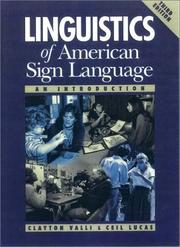
ISBN: 1563682184 9781563682186 1563680971 9781563680977 Year: 2000 Publisher: Washington, D.C. : Gallaudet University Press,
Abstract | Keywords | Export | Availability | Bookmark
 Loading...
Loading...Choose an application
- Reference Manager
- EndNote
- RefWorks (Direct export to RefWorks)
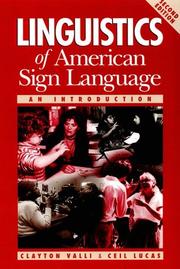
ISBN: 1563680424 Year: 1996 Publisher: Washington (D.C.) : Gallaudet university press,
Abstract | Keywords | Export | Availability | Bookmark
 Loading...
Loading...Choose an application
- Reference Manager
- EndNote
- RefWorks (Direct export to RefWorks)
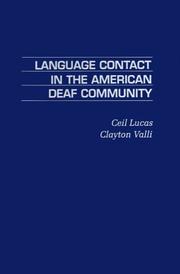
ISBN: 0124580408 9780124580404 Year: 1992 Publisher: San Diego: Academic press,
Abstract | Keywords | Export | Availability | Bookmark
 Loading...
Loading...Choose an application
- Reference Manager
- EndNote
- RefWorks (Direct export to RefWorks)
Deaf --- Sign language --- Pidgin languages --- American Sign Language
Book
ISBN: 9789004653337 9004653333 Year: 1992 Publisher: United Kingdom : BRILL,
Abstract | Keywords | Export | Availability | Bookmark
 Loading...
Loading...Choose an application
- Reference Manager
- EndNote
- RefWorks (Direct export to RefWorks)
Started in 1986 as a project to simply describe the linguistic and sociolinguistic features of contact signing and to determine if this type of signing is aptly labeled a pidgin, this book blossomed in depth as the authors' data increased. The initial narrow goals of the book expanded and now project a much larger picture of language contact in the American deaf community."We were forced ... to consider issues somewhat broader than those addressed by the (initial) project," writes Lucas in the preface. The result is a superbly-researched text, documenting the tireless efforts of Lucas and Valli over the last six years. Included in the book is a model of linguistic outcomes of language contact in the deaf community, the patterns of language use which emerged from the data, and the implications of the findings on deaf education, second language teaching, and interpreting.This book describes language contact in the deaf community within the larger context of studies of language contact. It reviews current issues and research on language contact. It re-examines claims that the outcome of language contact in the deaf community is a pidgin. It demonstrates what is unique about language contact in the deaf community based on analysis of videotaped data. It discusses the educational and teaching implications of findings with regard to language contact in the deaf community.
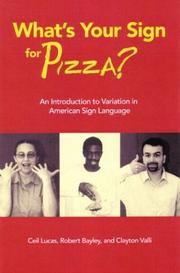
ISBN: 1563681447 9781563681448 Year: 2003 Publisher: Washington, D.C. : Gallaudet University Press,
Abstract | Keywords | Export | Availability | Bookmark
 Loading...
Loading...Choose an application
- Reference Manager
- EndNote
- RefWorks (Direct export to RefWorks)
This introductory text celebrates another dimension of diversity in the United States Deaf community -- variation in the way American Sign Language (ASL) is used by Deaf people all across the nation. The different ways people have of saying or signing the same thing defines variation in language.
ASL. --- American sign language. --- Amerikansk døvetegnsprog. --- Amerikansk tegnsprog. --- Døvetegnsprog. --- Tegnsprog.
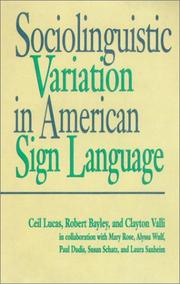
ISBN: 1563681773 9781563681776 1563681137 9781563681134 Year: 2001 Publisher: Washington, D.C.
Abstract | Keywords | Export | Availability | Bookmark
 Loading...
Loading...Choose an application
- Reference Manager
- EndNote
- RefWorks (Direct export to RefWorks)
This volume provides a complete description of ASL variation. People from varying regions and backgrounds have different ways of saying the same thing. For example, in English some people say "test," while others say "tes'," dropping the final "t." Noted scholars Ceil Lucas, Robert Bayley, and Clayton Valli led a team of exceptional researchers in applying techniques for analyzing spoken language variation to ASL. Their observations at the phonological, lexical, morphological, and syntactic levels demonstrate that ASL variation correlates with many of the same driving social factors of spoken languages, including age, socioeconomic class, gender, ethnic background, region, and sexual orientation. Internal constraints that mandate variant choices for spoken languages have been compared to ASL as well, with intriguing results.
American Sign Language --- Sociolinguistics. --- Deaf --- AMESLAN (Sign language) --- ASL (Sign language) --- Sign language --- Language and languages --- Language and society --- Society and language --- Sociology of language --- Language and culture --- Linguistics --- Sociology --- Integrational linguistics (Oxford school) --- Gesture language --- Speech-reading --- Speechreading --- Communication --- Social aspects. --- Means of communication. --- Social aspects --- Sociological aspects --- Education --- Speech --- #KVHA:Gebarentaal; Verenigde Staten --- #KVHA:Doventolken; Verenigde Staten
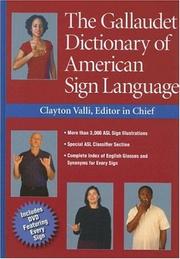
ISBN: 1563682826 Year: 2005 Publisher: Washington Gallaudet university press
Abstract | Keywords | Export | Availability | Bookmark
 Loading...
Loading...Choose an application
- Reference Manager
- EndNote
- RefWorks (Direct export to RefWorks)
Book
ISBN: 1954622023 9781954622029 9781954622012 1954622015 Year: 2021 Publisher: Washington, D. C.
Abstract | Keywords | Export | Availability | Bookmark
 Loading...
Loading...Choose an application
- Reference Manager
- EndNote
- RefWorks (Direct export to RefWorks)
| Listing 1 - 10 of 10 |
Sort by
|

 Search
Search Feedback
Feedback About UniCat
About UniCat  Help
Help News
News